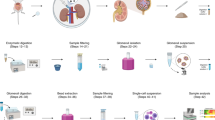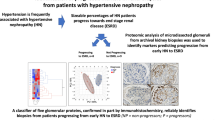Abstract
Recent studies have shown bone marrow (BM) cells to differentiate into a variety of cell types and to thereby participate in the reconstitution of damaged organs. In the present study, we examined the extent to which BM-derived cells are incorporated into glomeruli during recovery from experimentally induced nephritis. To investigate the localization of BM cells in glomeruli, chimeric mice were prepared by transplanting BM cells from green fluorescent protein (GFP) transgenic mice into wild-type mice. Five weeks later, glomerulonephritis was induced by intravenous injection of Habu snake venom. Groups of mice were then killed every few days for 42 d, and harvested kidney samples were subjected to immunohistochemical and immunoelectron microscopic analyses with the aim of detecting the presence of GFP(+) cells within glomeruli. Chimeric animals injected with Habu venom developed proliferative glomerulonephritis within 1–3 d. The lesion gradually subsided and the glomerular structure returned to normal within 42 d. Consistent with the disease course, large numbers of GFP(+) cells were present within glomeruli on d 1–3, but most had disappeared by d 7. Nevertheless, some GFP(+) cells did remain within glomeruli showing mesangial proliferative changes, and were found to express thrombomodulin (TM), a specific endothelial cell marker. These GFP-TM–double-positive cells accounted for a mean of 1.31–2.24% of the total glomerular nuclei from d 7 through d 42, levels that remained stable for at least 12 mo. It thus appears that BM cells can give rise to endothelial cells that participate in the remodeling of glomeruli.
Similar content being viewed by others
Log in or create a free account to read this content
Gain free access to this article, as well as selected content from this journal and more on nature.com
or
Abbreviations
- BM:
-
bone marrow
- E-GFP:
-
enhanced green fluorescent protein
- GFP:
-
green fluorescent protein
- HSV:
-
Habu snake venom
- TM:
-
thrombomodulin
References
McIntyre CW, Fluck RJ, Lambie SH 2001 Steroid and cyclophosphamide therapy for IgA nephropathy associated with crescenteric change: an effective treatment. Clin Nephrol 56: 193–198
Petersen BE, Terada N 2001 Stem cells: a journey into a new frontier. J Am Soc Nephrol 12: 1773–1780
Pittenger MF, Mackay AM, Beck SC, Jaiswal RK, Douglas R, Mosca JD, Moorman MA, Simonetti DW, Craig S, Marshak DR 1999 Multilineage potential of adult human mesenchymal stem cells. Science 284: 143–147
Orlic D, Kajstura J, Chimenti S, Limana F, Jakoniuk I, Quaini F, Nadal-Ginard B, Bodine DM, Leri A, Anversa P 2001 Mobilized bone marrow cells repair the infarcted heart, improving function and survival. Proc Natl Acad Sci U S A 98: 10344–10349
Asahara T, Murohara T, Sullivan A, Silver M, van der Zee R, Li T, Witzenbichler B, Schatteman G, Isner JM 1997 Isolation of putative progenitor endothelial cells for angiogenesis. Science 275: 964–967
Kalka C, Masuda H, Takahashi T, Kalka-Moll WM, Silver M, Kearney M, Li T, Isner JM, Asahara T 2000 Transplantation of ex vivo expanded endothelial progenitor cells for therapeutic neovascularization. Proc Natl Acad Sci U S A 97: 3422–3427
Lagasse E, Connors H, Al-Dhalimy M, Reitsma M, Dohse M, Osborne L, Wang X, Finegold M, Weissman IL, Grompe M 2000 Purified hematopoietic stem cells can differentiate into hepatocytes in vivo. Nat Med 6: 1229–1234
Bjornson CR, Rietze RL, Reynolds BA, Magli MC, Vescovi AL 1999 Turning brain into blood: a hematopoietic fate adopted by adult neural stem cells in vivo. Science 283: 534–537
Kopen GC, Prockop DJ, Phinney DG 1999 Marrow stromal cells migrate throughout forebrain and cerebellum, and they differentiate into astrocytes after injection into neonatal mouse brains. Proc Natl Acad Sci U S A 96: 10711–10716
Mezey E, Chandross KJ, Harta G, Maki RA, McKercher SR 2000 Turning blood into brain: cells bearing neuronal antigens generated in vivo from bone marrow. Science 290: 1779–1782
Nakano K, Migita M, Mochizuki H, Shimada T 2001 Differentiation of transplanted bone marrow cells in the adult mouse brain. Transplantation 71: 1735–1740
Imasawa T, Utsunomiya Y, Kawamura T, Zhong Y, Nagasawa R, Okabe M, Maruyama N, Hosoya T, Ohno T 2001 The potential of bone marrow-derived cells to differentiate to glomerular mesangial cells. J Am Soc Nephrol 12: 1401–1409
Ito T, Suzuki A, Imai E, Okabe M, Hori M 2001 Bone marrow is a reservoir of repopulating mesangial cells during glomerular remodeling. J Am Soc Nephrol 12: 2625–2635
Isner JM, Asahara T 1999 Angiogenesis and vasculogenesis as therapeutic strategies for postnatal neovascularization. J Clin Invest 103: 1231–1236
Carmeliet P, Luttun A 2001 The emerging role of the bone marrow-derived stem cells in (therapeutic) angiogenesis. Thromb Haemost 86: 289–297
Kitamura H, Sugisaki Y, Yamanaka N 1995 Endothelial regeneration during the repair process following Habu-snake venom induced glomerular injury. Virchows Arch 427: 195–204
Shimizu A, Masuda Y, Kitamura H, Ishizaki M, Sugisaki Y, Yamanaka N 1998 Recovery of damaged glomerular capillary network with endothelial cell apoptosis in experimental proliferative glomerulonephritis. Nephron 79: 206–214
Hayakawa J, Migita M, Ueda T, Shimada T, Fukunaga Y 2003 Generation of a chimeric mouse reconstituted with green fluorescent protein-positive bone marrow cells: a useful model for studying the behavior of bone marrow cells in regeneration in vivo. Int J Hematol 77: 456–462
Kuramochi Y, Fukazawa R, Migita M, Hayakawa J, Hayashida M, Uchikoba Y, Fukumi D, Shimada T, Ogawa S 2003 Cardiomyocyte regeneration from circulating bone marrow cells in mice. Pediatr Res 54: 319–325
Okabe M, Ikawa M, Kominami K, Nakanishi T, Nishimune Y 1997 ‘Green mice' as a source of ubiquitous green cells. FEBS Lett 407: 313–319
Horvat R, Palade GE 1993 Thrombomodulin and thrombin localization on the vascular endothelium; their internalization and transcytosis by plasmalemmal vesicles. Eur J Cell Biol 61: 299–313
Brittan M, Hunt T, Jeffery R, Poulsom R, Forbes SJ, Hodivala-Dilke K, Goldman J, Alison MR, Wright NA 2002 Bone marrow derivation of pericryptal myofibroblasts in the mouse and human small intestine and colon. Gut 50: 752–757
Hsu SM, Raine L, Fanger H 1981 Use of avidin-biotin-peroxidase complex (ABC) in immunoperoxidase techniques: a comparison between ABC and unlabeled antibody (PAP) procedures. J Histochem Cytochem 29: 577–580
Cattell V, Bradfield JW 1977 Focal mesangial proliferative glomerulonephritis in the rat caused by habu snake venom. A morphologic study. Am J Pathol 87: 511–524
Eitner F, Westerhuis R, Burg M, Weinhold B, Grone HJ, Ostendorf T, Ruther U, Koch KM, Rees AJ, Floege J 1997 Role of interleukin-6 in mediating mesangial cell proliferation and matrix production in vivo. Kidney Int 51: 69–78
Nakao N, Hiraiwa N, Yoshiki A, Ike F, Kusakabe M 1998 Tenascin-C promotes healing of Habu-snake venom-induced glomerulonephritis: studies in knockout congenic mice and in culture. Am J Pathol 152: 1237–1245
Cornacchia F, Fornoni A, Plati AR, Thomas A, Wang Y, Inverardi L, Striker LJ, Striker GE 2001 Glomerulosclerosis is transmitted by bone marrow-derived mesangial cell progenitors. J Clin Invest 108: 1649–1656
Rookmaaker MB, Smits AM, Tolboom H, Van'tWout K, Martens AC, Goldschmeding R, Joles JA, Van Zonneveld AJ, Grone HJ, Rabelink TJ, Varharr MC 2003 Bone-marrow-derived cells contribute to glomerular endothelial repair in experimental glomerulonephritis. Am J Pathol 163: 553–562
Iruela-Arispe L, Gordon K, Hugo C, Duijvestijn AM, Claffey KP, Reilly M, Couser WG, Alpers CE, Johnson RJ 1995 Participation of glomerular endothelial cells in the capillary repair of glomerulonephritis. Am J Pathol 147: 1715–1727
Terada N, Hamazaki T, Oka M, Hoki M, Mastalerz DM, Nakano Y, Mayer EM, Morel L, Petersen BE, Scott EW 2002 Bone marrow cells adopt the phenotype of other cells by spontaneous cell fusion. Nature 416: 542–545
Gobe GC, Axelsen RA, Harmon BV, Allan DJ 1988 Cell death by apoptosis following X-irradiation of the foetal and neonatal rat kidney. Int J Radiat Biol 54: 567–576
Acknowledgements
The authors thank Dr. David Stern and Dr. Yukio Yuzawa, Columbia University, New York, NY, for providing the anti-TM antibody; Ms. Kyoko Wakamatsu, Mr. Takashi Arai, and Ms. Arimi Ishikawa for expert technical assistance; Dr. Shigeru Sato, Ms. Akiko Adachi, and Mr. Yoshihiro Sasaki for technical support of electron microscopy; and Dr. Akira Shimizu, Dr. Ryuji Ohashi, Dr. Hiroshi Kitamura, Dr. Yukinari Masuda, Dr. Yuichi Sugisaki, Dr. Yu Fukuda, and Dr. Nobuaki Yamanaka for helpful discussions and advices.
Author information
Authors and Affiliations
Corresponding author
Rights and permissions
About this article
Cite this article
Hayakawa, M., Ishizaki, M., Hayakawa, J. et al. Role of Bone Marrow Cells in the Healing Process of Mouse Experimental Glomerulonephritis. Pediatr Res 58, 323–328 (2005). https://doi.org/10.1203/01.PDR.0000169997.45684.05
Received:
Accepted:
Issue date:
DOI: https://doi.org/10.1203/01.PDR.0000169997.45684.05
This article is cited by
-
Elevated Numbers of Circulating Very Small Embryonic-Like Stem Cells (VSELs) and Intermediate CD14++CD16+ Monocytes in IgA Nephropathy
Stem Cell Reviews and Reports (2018)
-
Unfractionated bone marrow cells attenuate paraquat-induced glomerular injury and acute renal failure by modulating the inflammatory response
Scientific Reports (2016)
-
Regeneration and Bioengineering of the Kidney: Current Status and Future Challenges
Current Urology Reports (2014)
-
Cardiac and renal cell therapies: similarities and differences
Kidney International Supplements (2011)



